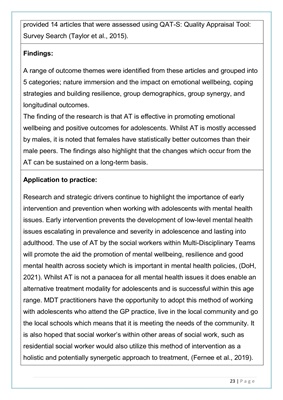
23 | P a g e
provided 14 articles that were assessed using QAT-S: Quality Appraisal Tool:
Survey Search (Taylor et al., 2015).
Findings:
A range of outcome themes were identified from these articles and grouped into
5 categories; nature immersion and the impact on emotional wellbeing, coping
strategies and building resilience, group demographics, group synergy, and
longitudinal outcomes.
The finding of the research is that AT is effective in promoting emotional
wellbeing and positive outcomes for adolescents. Whilst AT is mostly accessed
by males, it is noted that females have statistically better outcomes than their
male peers. The findings also highlight that the changes which occur from the
AT can be sustained on a long-term basis.
Application to practice:
Research and strategic drivers continue to highlight the importance of early
intervention and prevention when working with adolescents with mental health
issues. Early intervention prevents the development of low-level mental health
issues escalating in prevalence and severity in adolescence and lasting into
adulthood. The use of AT by the social workers within Multi-Disciplinary Teams
will promote the aid the promotion of mental wellbeing, resilience and good
mental health across society which is important in mental health policies, (DoH,
2021). Whilst AT is not a panacea for all mental health issues it does enable an
alternative treatment modality for adolescents and is successful within this age
range. MDT practitioners have the opportunity to adopt this method of working
with adolescents who attend the GP practice, live in the local community and go
the local schools which means that it is meeting the needs of the community. It
is also hoped that social worker's within other areas of social work, such as
residential social worker would also utilize this method of intervention as a
holistic and potentially synergetic approach to treatment, (Fernee et al., 2019).